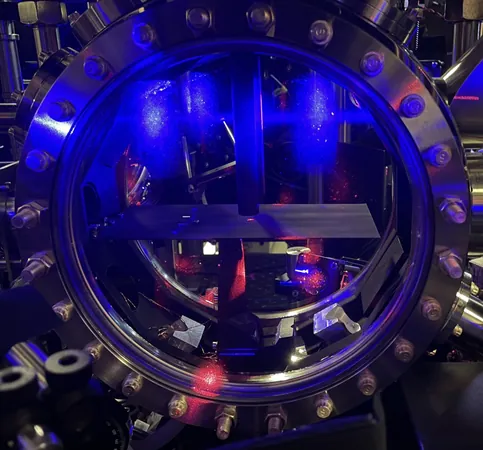
Revolutionary Breakthrough: Hours of Continuous Lasing with Laser-Cooled Strontium Atoms
2025-05-05
Author: Ken Lee
Unleashing the Power of Cold Atoms
In a groundbreaking development, scientists have achieved hours of continuous lasing using laser-cooled strontium-88 (88Sr) atoms. This innovation, emerging from JILA—a collaborative institute based at the University of Colorado-Boulder and the National Institute of Standards and Technology—leverages atomic gases chilled to near absolute zero, forming a dynamic platform to explore quantum phenomena.
From Short-Lived Effects to Continuous Lasing
Historically, fascinating effects such as self-organization phase transitions and lasing in atomic gases were fleeting, with scientists needing to repeatedly reload atoms in experimental setups. However, this new technique has turned that idea on its head, enabling persistent lasing that could revolutionize technologies like ultra-quiet lasers and quantum computing.
A Game-Changer for Quantum Measurements
"Our initial aim was to construct a continuous superradiant laser for precise frequency measurements," shared Dr. Vera M. Schäfer, leading author of the transformative study published in Nature Physics. This groundbreaking tool could immensely aid in explorations of dark matter and its associated mysteries.
The Paradox of Light and Frequency
The team's unexpected discovery unfolded when they noticed laser light emanating from their optical cavity while merely trying to load the strontium atoms. Lead researcher Prof. James K. Thompson likened the laser cavity to a bell—resonating at specific frequencies, only to find that altering the cavity's resonance barely impacted the emitted light's frequency.
Delving Deeper: The Physics Behind the Magic
This peculiar observation led to a deeper inquiry into the nature of light-matter interactions. The researchers realized that stable frequencies—crucial for atomic clocks and gravitational wave detectors—were disrupted by natural motion, or Brownian motion, of real atoms. Could a superradiant laser provide a solution?
An Innovative Cooling Method
By continuously applying lasers to cool strontium atoms to just 10 millionths of a degree above absolute zero, researchers enabled unprecedented stability. Zhijing Niu, a senior PhD student, noted, "We’ve developed a method to continuously cool and load atoms, breaking away from traditional staggered processes used in the field."
Unexpected Lasing and Its Implications
As they explored, the team found that lasing persisted for hours, leading to the realization that the interplay of laser-cooling and photon absorption created a feedback loop that stabilized the effective frequency of their optical cavity. "We stumbled upon a gain mechanism, a gift from nature, causing a recoil effect that drives continuous lasing," Niu explained.
New Frontiers in Quantum Technology
The study signifies a shift from cyclical to continuous experiments in atomic and laser physics, promising revolutionary advances in quantum sensors and computing systems. As Thompson remarked, "We plan to utilize the narrow linewidth transition to develop single-color lasers, with the potential to explore the quantum realm further."
A Bright Future Ahead
As the research progresses, the implications for technology are staggering. The insights gained could lead to enhanced optical clocks, superior gravitational wave detectors, and even advances in simulating complex quantum systems. The path forward is bright, and these researchers are poised to lead the charge into a new era of quantum exploration.


 Brasil (PT)
Brasil (PT)
 Canada (EN)
Canada (EN)
 Chile (ES)
Chile (ES)
 Česko (CS)
Česko (CS)
 대한민국 (KO)
대한민국 (KO)
 España (ES)
España (ES)
 France (FR)
France (FR)
 Hong Kong (EN)
Hong Kong (EN)
 Italia (IT)
Italia (IT)
 日本 (JA)
日本 (JA)
 Magyarország (HU)
Magyarország (HU)
 Norge (NO)
Norge (NO)
 Polska (PL)
Polska (PL)
 Schweiz (DE)
Schweiz (DE)
 Singapore (EN)
Singapore (EN)
 Sverige (SV)
Sverige (SV)
 Suomi (FI)
Suomi (FI)
 Türkiye (TR)
Türkiye (TR)
 الإمارات العربية المتحدة (AR)
الإمارات العربية المتحدة (AR)